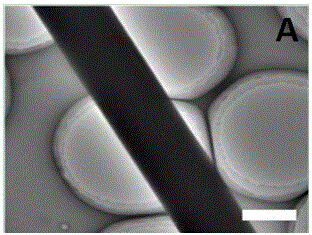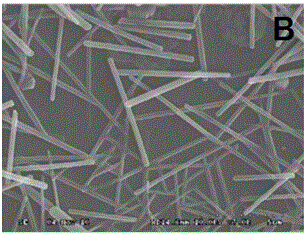Organic nano electrochemical luminescence response sensor and manufacturing method thereof
An electrochemical and sensor technology, applied in the field of electrochemiluminescent responsive material sensors, can solve the problems of weakening the conductivity of electrochemiluminescent sensors, affecting the detection performance of electrochemiluminescent materials, and failing to detect small molecules, so as to facilitate application and promotion , low detection limit and high detection sensitivity
- Summary
- Abstract
- Description
- Claims
- Application Information
AI Technical Summary
Problems solved by technology
Method used
Image
Examples
Embodiment 1
[0029] This embodiment relates to a group of organic nano-electrochemiluminescence responsive sensors and a preparation method thereof.
Embodiment 11
[0031] This embodiment relates to a bipyridyl ruthenium organic nano-electrochemiluminescence response sensor, and the specific preparation steps are as follows:
[0032] a. Obtain bipyridyl ruthenium organic nano-electrochemiluminescent response materials:
[0033] Prepare a bipyridyl ruthenium solution with a concentration of 0.05mmol / L, and the solvent is acetonitrile; add 10mL of acetonitrile into a 100mL beaker, then put a block object and make it protrude from the liquid surface by about 0.5 cm, and then place it on the block object Place a piece of quartz glass sprayed with Pt as the substrate and seal the beaker; quickly drop the bipyridyl ruthenium solution on the substrate with a syringe; after the solvent on the substrate evaporates slowly, a pair of solvent atmosphere is formed in the beaker, and the bipyridyl ruthenium molecules are in the liquid Gradually aggregate and self-assemble in the phase, and after 5-6 hours of self-assembly process, a large number of bip...
Embodiment 12
[0038] This embodiment relates to a rubrene organic nano-electrochemiluminescence response sensor, which is prepared by the following steps:
[0039] a. Obtain rubrene organic nano-electrochemiluminescence response materials:
[0040]Prepare a rubrene solution with a concentration of 0.04mmol / L, and the solvent is cyclohexane; add 15mL cyclohexane into a 100mL beaker, then put a block object and make it protrude from the liquid surface by about 0.5 cm, and then Put a piece of quartz glass sprayed with Pt on the block as the substrate and seal the beaker; use a syringe to draw rubrene solution and drop it quickly on the substrate; when the solvent on the substrate evaporates slowly, a solvent atmosphere is formed in the beaker, rubrene The alkene molecules gradually aggregated and self-assembled in the liquid phase. After 4-5 hours of self-assembly process, a large number of rubrene organic nanowires, that is, organic nano-electrochemiluminescent response materials were obtaine...
PUM
 Login to View More
Login to View More Abstract
Description
Claims
Application Information
 Login to View More
Login to View More - R&D
- Intellectual Property
- Life Sciences
- Materials
- Tech Scout
- Unparalleled Data Quality
- Higher Quality Content
- 60% Fewer Hallucinations
Browse by: Latest US Patents, China's latest patents, Technical Efficacy Thesaurus, Application Domain, Technology Topic, Popular Technical Reports.
© 2025 PatSnap. All rights reserved.Legal|Privacy policy|Modern Slavery Act Transparency Statement|Sitemap|About US| Contact US: help@patsnap.com



